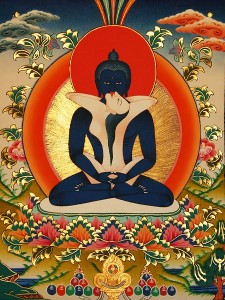The following is an excerpt from a teaching by Jetsunma Ahkon Lhamo called “Tools to Deepen Your Practice”
Today I would like to discuss the depth at which one practices. That is to say, how to avoid practicing in a superficial way where there is no mental or emotional investment. That’s really not the ideal kind of practice. It’s a little bit like watching TV, or listening to the radio, or something like that where you do it with half-a-mind, you know, and the rest of the time, of course, the mind is involved with other things. And so, we’ve all heard that we don’t want that to happen, that we want the mind to be gentled and stilled but yet we have a hard time understanding that really the key to that is the depth, the level, and the absorption with which we practice. That depth or that absorption is called the Dakini’s breath. That is actually what makes one’s practice relevant, delicious and sweet, meaningful and nourishing. Without that depth and that level of absorption, it’s very difficult to practice in any way that is more profound than say, recitation by rote. So that’s the effort that we want to make. In order to do that, I would like to explain things a little differently, perhaps a little more deeply than you may be used to.
One of the things that I would like to mention is that in Tantrayana, or the path of Vajrayana (which is the same thing), which is where we are now, you could say that the Path has two eyes or two legs, two supports. Another way to say it would be that the Path can be distilled to its essential nature in two words: wisdom and compassion. In fact one sees in many of the thangkas, the traditional paintings that are all around, pictures of a female and male in union, two lamas as consorts in union. And of course having ordinary minds and being used to billboards and stuff like that, we think “Oh, what is this?” But we shouldn’t look at those pictures with an ordinary mind because they have a profound meaning. The meaning of the union between lama and consort is the union of wisdom and compassion, the union of emptiness and method. The union of emptiness and method is the perfect balance, the perfect ship by which to cross the ocean of suffering. It’s the perfect vehicle. And of course, first we should understand what it means. Wisdom and compassion or emptiness and method. . . What does it really mean?
Well the meaning is this. First of all, wisdom is something that you cannot arrive at by accumulating facts, because facts are phenomenal. They are believed to be self-existing. They are part of samsara, even if they are very smart facts. Even if they are PhD-style facts! Even if they’re MD-style! No matter how many facts you know, you can never accumulate wisdom through the accumulation of facts, or what we would call the accumulation of knowledge. It’s not to say that the accumulation of knowledge is not necessary. If that were the case, then none of us would need training. We would simply sit and do our best at meditating.
Of course facts are necessary. It is necessary for us in our practice to understand how it is that the preceding lamas and excellent practitioners accumulated merit and how they accumulated tremendous achievement. It’s tremendously helpful to know facts, for instance, about the great lamas and the great saints and the Buddhas that have come in this time, and in other times, in order to understand with our ordinary minds what it is about them, how they come to be. In fact, to some degree, our ordinary minds do require satisfaction. And that’s where Vajrayana is ideal, because Vajrayana gives us ‘mental food.’ We have visualization. We have mantra recitation. We have the absorption in emptiness and then the springing from emptiness as the deity; and then the vajra confidence and the vajra pride. It’s busy work! Sometimes when people who are used to just sitting quietly and doing whatever it is they do, you know, when they have that habit of just sitting quietly, and there is a part of Vajrayana Buddhism in which you do sitting meditation; but if students only have that experience, they come here and they say, “Well, my mind is not calm. I’m reciting all this stuff and I’m really stressed because I can hardly pronounce it. And the tunes—forget about it. And so there!” And of course the response to that is, “Well really in Vajrayana the task is not to calm the mind. The task is to awaken to the emptiness of all nature,to awaken to emptiness, that is, to perceive emptiness.”
Copyright © Jetsunma Ahkon Norbu Lhamo All rights reserved












Your teachings are always timely for me, Precious Lama. I come to your wonderul Tibetan Buddhist Altar seeking renewal and inspiration and always there is something for me that I need. The truth is I sometimes think Vajrayna practice is too busy, and I long to just sit and meditate – which means, I guess, that I just want to have a sleep. How could I practise – how could I wake up – without the Guru? I could not.